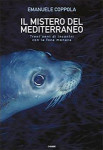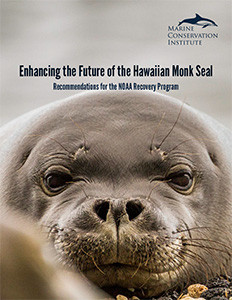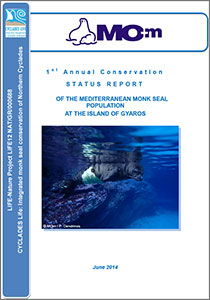 Recent Publications
Recent Publications
Il mistero del Mediterraneo. Trent’anni di incontri con la foca monaca.
Author: Emanuele Coppola
Publisher: Orme Editori
ISBN: 978-8867101405
[in Italian]

The Monachus-Guardian — Headlines-News-Articles — 2008-2018
Dedicated to Monk Seals and their Threatened Habitats
Chandler, W., E. Douce, K. Shugart-Schmidt, T. Watson, M. Sproat, F. Rosenstiel, K. Yentes, X. Escovar-Fadul, and T. Laubenstein. 2015. Enhancing the future of the Hawaiian monk seal: recommendations for the NOAA recovery program. Marine Conservation Institute. Seattle, WA: 1-80. [PDF 4.3MB]
Executive Summary
 Marine Conservation Institute undertook this report on the Hawaiian Monk Seal Recovery Program for the purpose of enhancing the conservation prospects of one of the world’s most endangered pinnipeds. The Hawaiian monk seal (Neomonachus schauinslandi), whose estimated population now hovers between 900 and 1,100 animals, has suffered a 60-year decline despite the efforts of National Oceanic and Atmospheric Administration’s (NOAA) National Marine Fisheries Service (NMFS) and others to reverse it. Although some may view the seal’s fate as hopeless, it is not. Despite difficult circumstances, NMFS and its partners have made progress on several fronts to slow the seal’s decline. Encouragingly, NMFS estimates that up to 32 per cent of all seals living in 2012 were alive because of hundreds of interventions taken by the agency over many years to enhance the survival of individual seals at risk. Continue reading “Enhancing the future of the Hawaiian monk seal: recommendations for the NOAA recovery program”
Marine Conservation Institute undertook this report on the Hawaiian Monk Seal Recovery Program for the purpose of enhancing the conservation prospects of one of the world’s most endangered pinnipeds. The Hawaiian monk seal (Neomonachus schauinslandi), whose estimated population now hovers between 900 and 1,100 animals, has suffered a 60-year decline despite the efforts of National Oceanic and Atmospheric Administration’s (NOAA) National Marine Fisheries Service (NMFS) and others to reverse it. Although some may view the seal’s fate as hopeless, it is not. Despite difficult circumstances, NMFS and its partners have made progress on several fronts to slow the seal’s decline. Encouragingly, NMFS estimates that up to 32 per cent of all seals living in 2012 were alive because of hundreds of interventions taken by the agency over many years to enhance the survival of individual seals at risk. Continue reading “Enhancing the future of the Hawaiian monk seal: recommendations for the NOAA recovery program”
![]()
Özgür Emek Inanmaza, Özgür Değirmenci and Ali Cemal Gücü. 2014. A new sighting of the Mediterranean Monk Seal, Monachus monachus (Hermann, 1779), in the Marmara Sea (Turkey). Zoology in the Middle East, 60 (3): 278-280. DOI:10.1080/09397140.2014.944438
[…] In total six caves displaying Monk Seal resting/breeding characteristics (see Karamanlidis, Pires, Silva, & Neves, 2004; Gucu, Gucu, & Orek, 2004) were discovered. There was clear evidence in one of those cases, namely the peculiar odour and tracks on the inner sandy beach, and this indicated the recent presence of a seal in the cave. The cave had a surface opening with an inner area and a platform formed by sand, pebbles and large boulders. During the surveys, seals were sighted at four different occasions on 21 April, 27-30 May and 14 June 2014, and were recorded on a video. […]

MOm. 2014. 1st annual conservation status report of the Mediterranean monk seal population at the island of Gyaros. 1-30. [PDF 1.5MB]
[…] Annual pup productivity
The minimum mean annual number of births (n = 7.75) recorded at the island of Gyaros is one of the highest recorded for the species in the Mediterranean Sea and could be higher if systematic assessments of natality were conducted throughout the breeding season at each site in the years 2004 – 2011. Systematic surveys of annual pup production at Cabo Blanco in the Western Sahara (González et al., 2002), the Northern Sporades, Kimolos & Polyaigos, and at Karpathos & Saria (MOm, 2007) yielded counts of 25.0, 8.4, 7.9, and 3.7, respectively. […]
![]() Alexandros A. Karamanlidis, P. Jeff Curtis, Amy C. Hirons, Marianna Psaradellis, Panagiotis Dendrinos and John B. Hopkins III. 2014. Stable isotopes confirm a coastal diet for critically endangered Mediterranean monk seals. Isotopes in Environmental and Health Studies, http://dx.doi.org/10.1080/10256016.2014.931845.
Alexandros A. Karamanlidis, P. Jeff Curtis, Amy C. Hirons, Marianna Psaradellis, Panagiotis Dendrinos and John B. Hopkins III. 2014. Stable isotopes confirm a coastal diet for critically endangered Mediterranean monk seals. Isotopes in Environmental and Health Studies, http://dx.doi.org/10.1080/10256016.2014.931845.
Abstract
Understanding the ecology and behaviour of endangered species is essential for developing effective management and conservation strategies. We used stable isotope analysis to investigate the foraging behaviour of critically endangered Mediterranean monk seals (Monachus monachus) in Greece. We measured carbon and nitrogen isotope ratios (expressed as δ13C and δ15N values, respectively) derived from the hair of deceased adult and juvenile seals and the muscle of their known prey to quantify their diets. We tested the hypothesis that monk seals primarily foraged for prey that occupy coastal habitats in Greece. We compared isotope values from seal hair to their coastal and pelagic prey (after correcting all prey for isotopic discrimination) and used these isotopic data and a stable isotope mixing model to estimate the proportion of coastal and pelagic resources consumed by seals. As predicted, we found that seals had similar δ13C values as many coastal prey species and higher δ13C values than pelagic species; these results, in conjunction with mean dietary estimates (coastal=61 % vs. pelagic=39 %), suggest that seals have a diverse diet comprising prey from multiple trophic levels that primarily occupy the coast. Marine resource managers should consider using the results from this study to inform the future management of coastal habitats in Greece to protect Mediterranean monk seals.
![]() Erdem Danyer, Işıl Aytemiz, Ali Cemal Gücü, Arda M. Tonay. 2014. Preliminary study on a stranding case of Mediterranean monk seal Monachus monachus (Hermann, 1779) on the Eastern Mediterranean coast of Turkey. Journal of the Black Sea / Mediterranean Environment 20(2): 152-157. [Download]
Erdem Danyer, Işıl Aytemiz, Ali Cemal Gücü, Arda M. Tonay. 2014. Preliminary study on a stranding case of Mediterranean monk seal Monachus monachus (Hermann, 1779) on the Eastern Mediterranean coast of Turkey. Journal of the Black Sea / Mediterranean Environment 20(2): 152-157. [Download]
Abstract
The Mediterranean monk seal Monachus monachus (Hermann, 1779) is one of the critically endangered species in the world and in the northeast Mediterranean Sea there is a continuously breeding population. On 28 February 2014, 3-3.5 months old, male Mediterranean monk seal stranded near Yasilovacık Harbour, Mersin. Gross necropsy was carried out one day later. The seal was emaciated and lungs were pneumonic. This paper summarizes the preliminary findings of the gross necropsy.
Further information: Monk seal breeding cave in Turkey threatened by harbour construction.